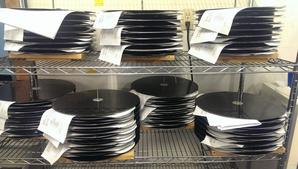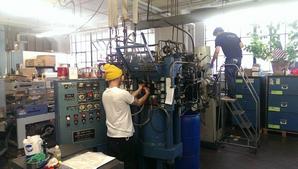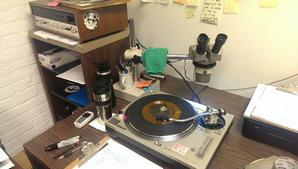By Jeannie Reall
CORRESPONDENT
Published: November 18, 2014 3:37 pm ET
Updated: November 18, 2014 9:35 pm ET

Image By: Gotta Groove Records Inc.
Vinyl records waiting for final labels and assembly at Gotta Groove Records Inc.
The recording industry is taking vinyl for a spin. Again.
Twenty-five years ago when Plastics News was ramping up printing presses, record presses were shutting down. The Los Angeles Timesproclaimed in a Feb. 24, 1989 headline: “Bye-bye, vinyl, bye-bye: Music Plus and other stores stop selling LP records, cite slow sales and rise of CDs.”
Now newspapers are shrinking and vinyl records are back.
Vinyl in other uses has been vilified in recent years for many reasons, mainly environmental. Maybe it was destiny, given vinyl was “phonetically disadvantaged” from the start, notes textbook author and materials authority Mike Ashby in his “Unappreciated Materials” blog.
Vinyl records suffered the indignity of being supplanted by cassettes, which gave CDs an easy opening: Anything sounded great by comparison. Once prized for their portability, CDs began losing ground to digital downloads and now, to the rising popularity of streaming services such as Pandora and Spotify.
Overall, retail music sales slipped almost 5 percent to $3.2 billion in the first half of 2014, compared with the same period in 2013, according to the Washington-based Recording Industry Association of America’s midyear report.
Total sales in physical formats like CDs (as opposed to downloads and streaming) dropped to $898 million in the first half of this year, down 14 percent compared with the first half of 2013. While vinyl records account for only 16 percent of that category, their sales shot up 43 percent to $146 million in that same period, RIAA said.
Sales of vinyl LPs have grown each year since 2006. Record pressers say the rise is significant.
“We take it very seriously,” said Matt Earley, vice president of sales and marketing for Gotta Groove Records Inc., which launched in 2009 — just after vinyl album sales took a serious jump, almost doubling to 1.9 million units from the year before. Unit sales in 2013 reached 6.1 million, the highest level since 1991, according to New York-based Nielsen Co.’s SoundScan.
“At this point the growth rate continues to climb bigger and faster than any of us had anticipated even a few years ago. I suppose in a few years, maybe, it might begin to level off, but we haven’t seen that yet,” Earley said in a phone interview.
The Cleveland company — located only a few miles from the Rock and Roll Hall of Fame and Museum — employs about two dozen workers and can put out some 70,000 records a month, running six of its seven presses at a time. It’s currently on the lookout for parts for an eighth machine, which it hopes to operate in adjacent space it is expanding into at the one-time elevator factory.
Gotta Groove owner Vince Slusarz worked 24 years for injection molder Kinetico Corp., beginning as general counsel and later assuming operational responsibility. Slusarz said his manufacturing experience at the Newbury, Ohio-based maker of water-filtration valves gave him the background he needed to start compression molding at Gotta Groove — though the business is “whole unto its own.”

Image By: Gotta Groove Records Inc.
Production at Gotta Groove Records.
Gotta Groove gets its PVC from Bangkok-based Thai Plastic and Chemicals Public Co. Ltd. and Rimtec Corp., which claims to be the only U.S. manufacturer of vinyl for records. Frank Hutzler, vice president of sales and marketing for the PVC compounder in Burlington, N.J., said the record industry accounts for less than 2 percent of Rimtec’s annual sales of roughly $100 million, but he’s definitely noticed the upswing in the market.
“It’s a medium that can’t really be knocked off. It has extraordinary resilience,” he said in a phone interview. “Audiophiles are adamant that it has a much truer sound. It’s what they like — the feel, the nostalgia.”
Rimtec, which employs about 100, is a joint venture between Riken Technos Corp. and Mitsubishi Corp., both of Tokyo, and Mitsubishi International Corp. in New York.
Independent CD giant Disc Makers of Pennsauken Township, N.J., near Philadelphia, saw the writing on the wall and recently re-entered vinyl records, buying back equipment it had sold some 20 years ago.
“Our managers have been here for decades and know how all this works,” Jim Foley, production and logistics manager, said in a news release. “The guy who manages our CD plant is the guy who managed our record plant.”
In another declaration of faith in vinyl’s comeback, one of the biggest producers of vinyl LPs is getting even bigger.

Image By: Gotta Groove Records Inc.
Quality control at Gotta Groove.
United Record Pressing LLC of Nashville, Tenn., recently bought a second facility there. Marketing director Jay Millar said the company hopes to start some production at the 142,000-square-foot facility this year and expects the site to be fully operational in 2015.
“Our business has been growing for over 10 years now,” Millar said by phone.
A quarter-century ago when vinyl LPs began their decline, United had about 12 presses. While other pressers were going out of business, United was buying up their equipment. It now has 22 presses — and will be putting 16 more into operation when it opens the second plant.
“Things have never really gotten bleak for us,” Millar said. “And we’ve been running 24 hours a day, six days a week, for the most part, for two years now.”
Digital files satisfy the desire for convenience, but audiophiles, die-hards and DJs want “a bigger, better concept,” Millar said, adding he thinks the trend is sustainable.
“We don’t believe [vinyl] is going anywhere,” he said.
0 Comments
| 